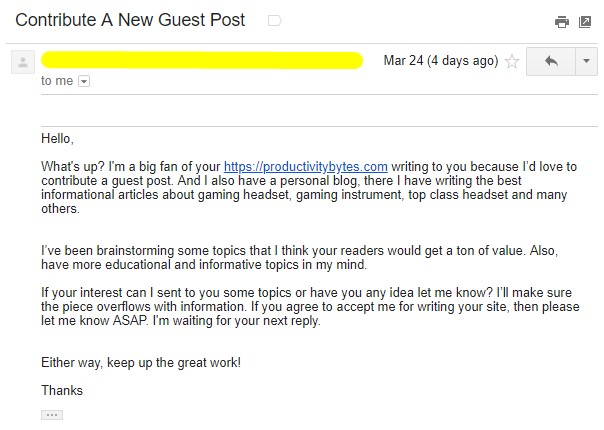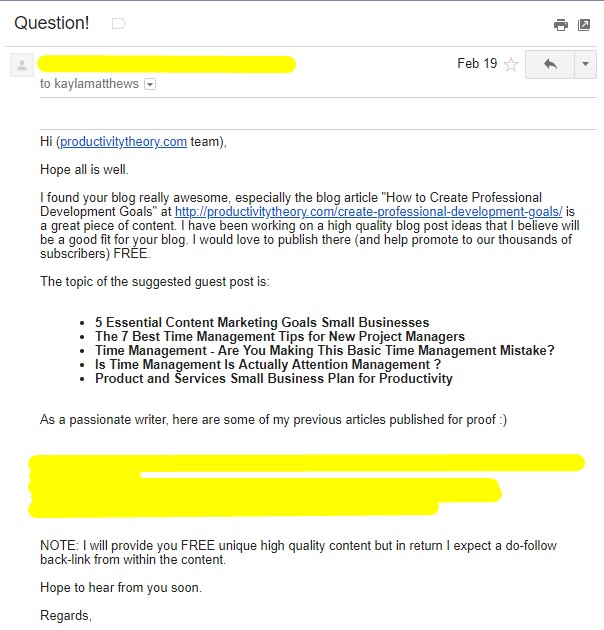
While you’re immersed in the flow of the day, an article idea springs forward into your mind — it’s brilliant! You know just the outlet to send it to!
You quickly write up your pitch. Hit send. Wait… and get no response.
As a blogger and writer, I see the characteristics of bad pitches on a daily basis in my inbox. I often don’t even need to open the email to know that it’s one to be ignored.
I sometimes forgive awkward subject lines and the odd typos. For many writers and editors, though, the amount of daily pitches overwhelms and we don’t have time to read low-quality ones.
All writers face rejection — it’s part of learning, surviving and thriving in the industry. I’ve been there, and I’m still there more often then I’d like to admit. But I’ve learned that every day presents an opportunity to grow more in your work and develop the mindfulness to craft a better pitch.
So, from the receiving side of the pitch, here are some things that make me ignore a pitch immediately, and what you can do to fix them. For your viewing pleasure, I’ve also included some examples of poor pitch emails I’ve received in the past. (Note: all identifying information has been removed from the screenshots. I’m not heartless, people.)
Poor grammar and typos = heck nos
It’s easy to get distracted by the myriad thoughts streaming through your mind as you try to put your pitch into the perfect words.
Typos happen. Grammar slides wayside. However, don’t blame the lack of coffee when you’re guilty of 13 distinct typos in a short two-paragraph pitch.
Glaring mistakes reveal more than repetitive writer ticks — it reveals a long series of edits I will have to make to your final post, which I don’t typically have time to do.

Pitch Fix: Print out your pitch and go over it. Rough drafts always apply to pitches. Step away for a few minutes. Invest in an AP style guide, Strunk and White’s classic “The Elements of Style” and handy websites like Grammar Girl and Grammarly to catch mistakes.
Inconsistent capitalization
Again, typos happen. But when a weird capitalization pattern emerges, your pitch will be denied.
Look out for words capitalized in the Middle of Sentences like This.
In best case scenarios, I’ll assume this mistake comes from a habit of using texting language on a daily basis and/or a need to work on spelling. In the worst case scenarios, I’ll assume you’re using some kind of automated system or third party to write your emails (and posts) for you.

Pitch Fix: Don’t type and send pitches on your smartphone, and definitely don’t use shoddy software to send your pitches for you. A pitch may derive from an idea, but it should be clear and concisely communicated.
Leading with “I work for [insert company name here]”
I understand your point of view that leading with “I work for COMPANY” may communicate transparency or show authority and experience, but it immediately tells me that your interest is in you and your company, not my blog and I.
I’m looking for individuals the readers of my niche and blogs will connect with as people and professionals. If your primary concern is talking about your company, you can take your ideas elsewhere.
Pitch Fix: Know the difference between marketing your writing versus marketing your company. A position listing under your name may show experience, but your pitch needs to be 100% focused on the goals of my blog and my readers.
Irrelevant or unprofessional links
You’ve interested me with a solid idea in the subject line and a polite, professional greeting. You lose me when you link to work lacking your name or pages that no longer exist.
Red flags wave instantly in my mind as an ethics issue. Don’t claim someone else’s work as yours because at worst you will get hit with a lawsuit. At best, the sample could be from a project you did for a client — but did you just break a contract?
Samples to your past work tell me that you’re familiar with how an editorial process works and give me an idea of the kinds of articles you write. Not including samples is forgiveable if you’re brand new to writing, but I’d hope to see a personal blog or at least some Medium posts if that’s the case.
Pitch Fix: Always send along sample links when possible, and make sure your name is clearly visible as the author of the post. You take a risk by including a sample without a byline. And, if you’re showing me website content you did for a client that had a relevant tone you wish to evoke, concisely explain, please.
Pitching a completed post
If someone pitches me with a full-length post, they’re likely to get ignored.
I always request new writers they look over the writing guidelines of my blogs and send me some sample ideas first. Not only are Productivity Theory’s writing guidelines not the same as those for Productivity Bytes, but I’ve found that many guest writers don’t make their initial pitches specific enough to my audiences.
I look for your connection to my audience, not necessarily your content. If the connection isn’t there, you can almost guarantee I won’t accept the post.
Pitch Fix: Don’t include your full post when you pitch. Instead, reach out to the editor first to verify the kind of pieces they’re looking for and write up that article instead. In my experience, most editors are willing to wait longer for an on-target post than immediately get the same post that’s been re-written on hundreds of other sites around the web.
Immediately promising free or overly-ambitious posts
I can definitely see the value in promoting your writing by offering it for free, but here’s the issue: if you immediately start a pitch by saying you’ll write free, unique and original content, you arouse suspicion. Why would you feel the need to promise those things if you’re a professional writer?
Most writers don’t offer their work for free right off the bat, and most of us understand up front that any pitched topic should be unique to the publication we’re pitching.

Pitch Fix: Show, don’t tell. This writerly adage is a vital truth and commandment across media and genres. What’s the story? Show me how this will be quality with original thinking and evidence. Show me you considered my audience and your piece won’t exist in a vacuum. If you want to add clips to your portfolio and write as a volunteer, leave that part for the end of the pitch.
In my opinion, these six characteristics will get your pitch email closed out faster than you can say “I’ve really enjoyed reading your awesome website.” (A staple phrase of the generic pitch email.)
Growing your craft as a writer is essential to your development and success, but you need to make sure your emails are getting read first.
Give these tips a try, and your response rates are likely to improve.
Get the TNW newsletter
Get the most important tech news in your inbox each week.




